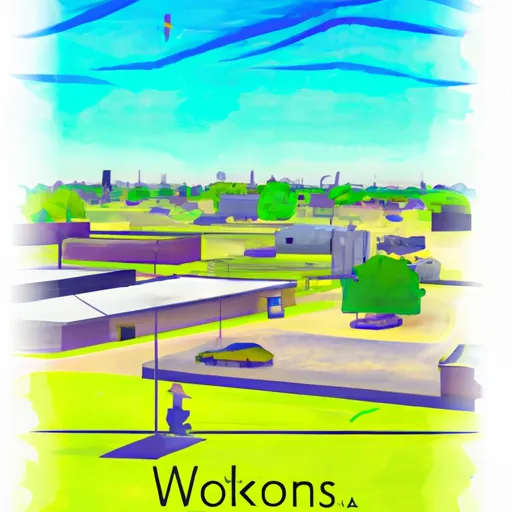-
 Snoflo Premium
Snoflo Premium
Get unlimited access to all our content
With no Ad interruptions! - Start Your Free Trial Login with existing account
Narka
Eden Index
Climate
8.1
•
Recreation
1.0
•
Community
•
Safeguard
3.6/10

Narka, Kansas is a small town located in Republic County. The climate in Narka is characterized by hot summers and cold winters. Summers are typically warm and humid, with temperatures averaging around 90°F (32°C). Winters, on the other hand, are cold and often experience snowfall, with temperatures dropping to around 20°F (-6°C).
Hydrologically, Narka is primarily influenced by the nearby Republican River. The river provides a source of water for the region and supports various aquatic ecosystems. Additionally, the area is dotted with small creeks and ponds, which further contribute to the hydrology of the region.
Outdoor recreation opportunities in Narka are abundant. The surrounding landscape offers opportunities for hunting, fishing, and wildlife observation. The Republican River provides an excellent setting for fishing enthusiasts, with a variety of fish species, including bass and catfish. The region's picturesque natural surroundings also attract hikers and nature lovers, who can explore the numerous trails and enjoy the scenic beauty of the area.
In conclusion, Narka, Kansas offers a diverse climate with hot summers and cold winters. The hydrology of the region is mainly influenced by the Republican River and various smaller water bodies. Outdoor enthusiasts can indulge in activities such as fishing, hunting, and hiking, making Narka a suitable destination for nature lovers.
What is the Eden Index?
The Snoflo Eden Index serves as a comprehensive rating system for regions, evaluating their desirability through a holistic assessment of climate health, outdoor recreation opportunities, and natural disaster risk, acknowledging the profound impact of these factors on livability and well-being.
Climate Health Indicator (CHI): 8.1
Narka receives approximately
749mm of rain per year,
with humidity levels near 81%
and air temperatures averaging around
12°C.
Narka has a plant hardyness factor of
5, meaning
plants and agriculture in this region thrive during a short period during spring and early summer. Most
plants will die off during the colder winter months.
By considering the ideal temperature range, reliable water supplies, clean air, and stable seasonal rain or snowpacks, the Climate Health Indicator (CHI) underscores the significance of a healthy climate as the foundation for quality living.
A healthy climate is paramount for ensuring a high quality of life and livability in a region, fostering both physical well-being and environmental harmony. This can be characterized by ideal temperatures, reliable access to water supplies, clean air, and consistent seasonal rain or snowpacks.
Weather Forecast
Streamflow Conditions
Big Blue
Area Rivers
Big Blue
Snowpack Depths
Big Blue
Reservoir Storage Capacity
Big Blue
Groundwater Levels
Recreational Opportunity Index (ROI): 1.0
The Recreational Opportunity Index (ROI) recognizes the value of outdoor recreational options, such as parks, hiking trails, camping sites, and fishing spots, while acknowledging that climate plays a pivotal role in ensuring the comfort and consistency of these experiences.
Access to outdoor recreational opportunities, encompassing activities such as parks, hiking, camping, and fishing, is crucial for overall well-being, and the climate plays a pivotal role in enabling and enhancing these experiences, ensuring that individuals can engage in nature-based activities comfortably and consistently.
Camping Areas
| Campground | Campsites | Reservations | Toilets | Showers | Elevation |
|---|---|---|---|---|---|
| Crystal Springs Lake | 60 | 1,314 ft | |||
| Buckley Creek | 4 | 1,429 ft | |||
| Berner Memorial Campground | None | 1,275 ft |
Catastrophe Safeguard Index (CSI):
The Catastrophe Safeguard Index (CSI) recognizes that natural disaster risk, encompassing floods, fires, hurricanes, and tornadoes, can drastically affect safety and the overall appeal of an area.
The level of natural disaster risk in a region significantly affects safety and the overall livability, with climate change amplifying these risks by potentially increasing the frequency and intensity of events like floods, fires, hurricanes, and tornadoes, thereby posing substantial challenges to community resilience and well-being.
Community Resilience Indicator (CRI):
The Community Resilience Indicator (CRI) recognizes that education, healthcare, and socioeconomics are crucial to the well-being of a region. The CRI acknowledges the profound impact of these elements on residents' overall quality of life. By evaluating educational resources, healthcare accessibility, and economic inclusivity, the index captures the essential aspects that contribute to a thriving community, fostering resident satisfaction, equity, and social cohesion.

